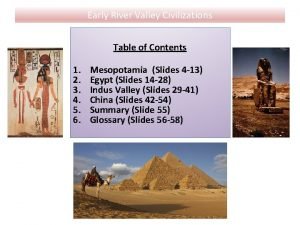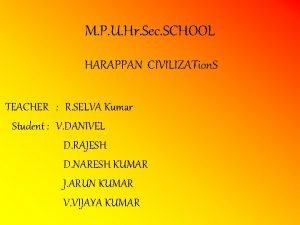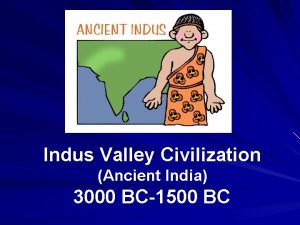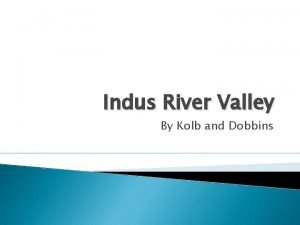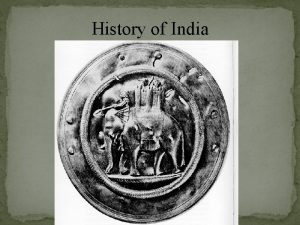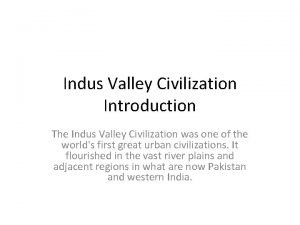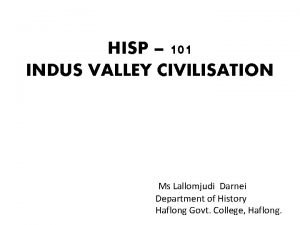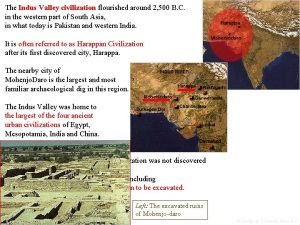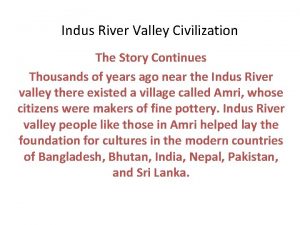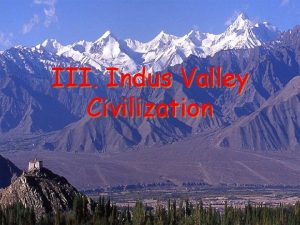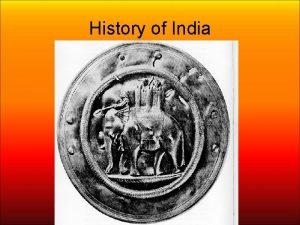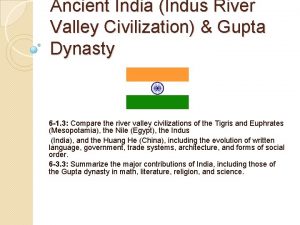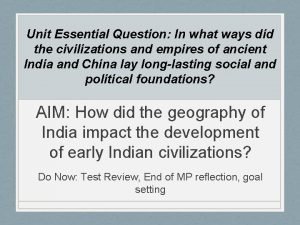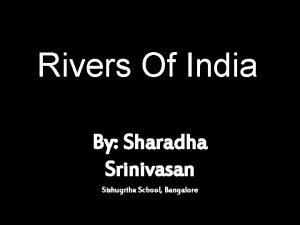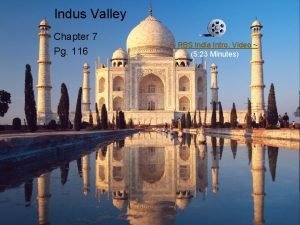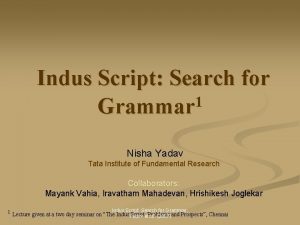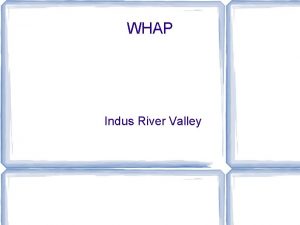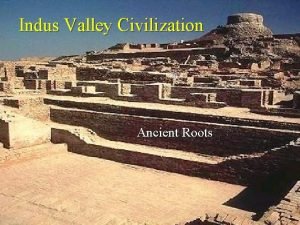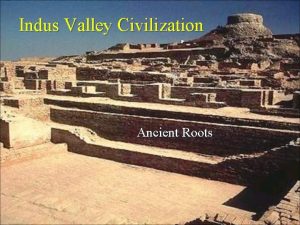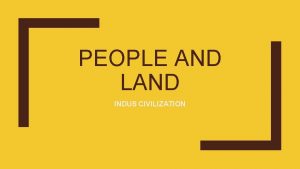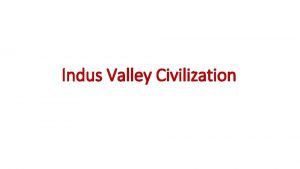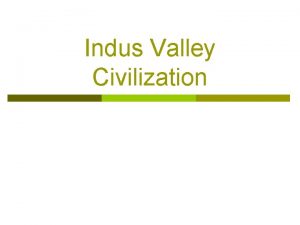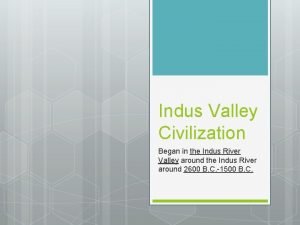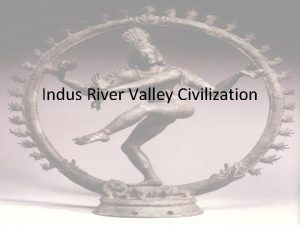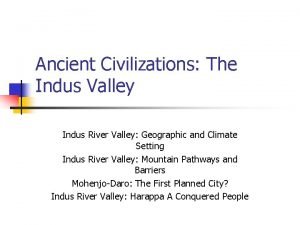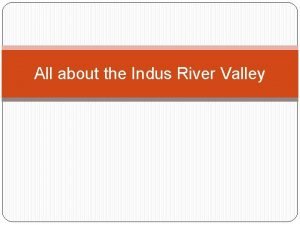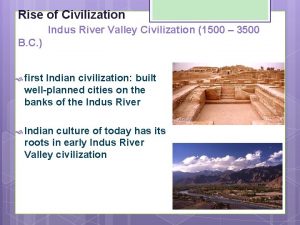Indus River Valley Civilization World Studies Old World

















- Slides: 17

Indus River Valley Civilization World Studies

Old World Civilizations

Cities The similarities in plan and construction between Mohenjo. Daro and Harappa indicate that they were part of a unified government with extreme organization. – Both cities were constructed of the same type and shape of bricks. – The two cities may have existed simultaneously and their sizes suggest that they served as capitals of their provinces. – In contrast to other civilizations, burials found from these cities are not elaborate; they are more simplistic and contain few material goods. – Remains of palaces or temples in the cities have not been found. – No hard evidence exists indicating military activity, though the cities did contain fortifications and artifacts such as copper and bronze knives, spears, and arrowheads were recovered.

Streets • At Mohenjo-Daro narrow streets and alleyways are off of the major streets, leading into more private neighborhoods. • Many of the brick houses were two stories high, with thick walls and high ceilings to keep the rooms cool in the hot summer months.

Identify • Harrapa was an ancient city in the Indus River Valley. It had narrow streets with thick uniform brick walls, public wells, and no evidence of temples or palaces. This was one of the earliest cities with a public sewer system.

Artisans & goldsmiths • This collection of gold and agate ornaments (see next slide) includes objects found at both Mohenjo-Daro and Harappa. • At the top are fillets of hammered gold that would have been worn around the forehead. • The other ornaments include bangles, chokers, long pendant necklaces, rings, earrings, conical hair ornaments, and broaches. • These ornaments were never buried with the dead, but were passed on from one generation to the next. • These ornaments were hidden under the floors in the homes of wealthy merchants or goldsmiths.

Necklace • Necklace from Mohenjo-Daro made from gold, agate, jasper, steatite and green stone. • The gold beads are hollow and the pendant agate and jasper beads are attached with thick gold wire. • Steatite beads with gold caps serve to separate each of the pendant beads.

Craft Specialization • Figurine manufacturers used lost wax process: wax model, cover with clay, fire to melt way, then pour molten metal inside • Carnelian bead manufacture extensive • Stamp seals made of soap stone—especially of animal figures • Most crafts originated in villages and then moved to cities where mass production occurred

Identify

Harrapa Sewer System Public Sewer

Harrapan bath in Elite Home Bath area at Harrapa: Such facilities were tied into a public drainage system

Public Well, Mohenjodaro

Identify

Language • The Indus (or Harappan) people used a pictographic script. • Some 3500 specimens of this script survive in stamp seals carved in stone, in molded terracotta and faience amulets, in fragments of pottery, and in a few other categories of inscribed objects. • In addition to the pictographic signs, the seals and amulets often contain iconographic motifs, mostly realistic pictures of animals apparently worshipped as sacred, and a few cultic scenes, including anthropomorphic deities and worshippers. • This material is important to the investigation of the Harappan language and religion, which continue to be major issues.

Ancient Indus

Identify

The Collapse, c. 2000 BC • Reached its peak about 2300 BC • About 2000 BC, Harrapa and Mohenjodaro in decline and soon abandoned • Cities dispersed, trade decreased dramatically • Wheeler’s Theory: The Invasion of Aryan speakers, yet this was not recorded until 1000 BC • Tectonic movement—a natural dam that flooded Mohenjadaro or drying of two major rivers • Environmental: Rising populations + rapid clearance for crops and more grazing, brick baking.
 Mesopotamia technology
Mesopotamia technology Ancient medication
Ancient medication Harappan civilization
Harappan civilization Aryan civilization
Aryan civilization Economy of indus civilization
Economy of indus civilization Indus valley civilization trade and economy
Indus valley civilization trade and economy Introduction of indus valley civilization
Introduction of indus valley civilization Indus valley civilization conclusion
Indus valley civilization conclusion Indus valley resources
Indus valley resources The indus valley flourished from to bc
The indus valley flourished from to bc Indus valley civilization recreation
Indus valley civilization recreation Indus valley game
Indus valley game Economy of indus valley civilization
Economy of indus valley civilization Language b
Language b Map of harappa
Map of harappa Conclusion of harappan civilization
Conclusion of harappan civilization Indus valley civilization period
Indus valley civilization period Under 70
Under 70
